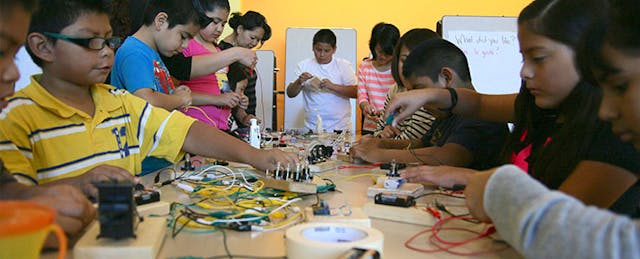You see it everywhere in K-12. Kindergarteners design toys for their friends to practice empathy, while learning to use a saw and glue-gun along the way. Second graders deepen their understanding of character traits while designing and sewing puppets to represent a character in a folk-tale. In high school physics, students make wind turbines in order to internalize an understanding of how magnetism can create electricity.
The “it” I’m referring to is “Making,” and simply put, Making is any activity where people create something, often with their hands.
I often define Making by looking at what people bring to the Maker Faire, which does include more technical aspects like 3D printing, physical computing and programming. But Making also includes woodworking, growing food, making art and crafts.
So what makes “Making” different from traditional classes? When people Make, they mix things together in new ways.
We have arrived at a time when many of the high-tech aspects of Making--such as physical computing or 3D design and manufacturing--are more readily accessible. Take e-textiles: an e-textile is a combination of physical-computing and textiles, where people create items like a turn-signal biking jacket or an LED-tutu.
So why use Making in K-12 schools?
Making gives students (or anyone, really) an opportunity to find a passion. Additionally, Making provides a context to place academic learning in the “heart, mind, and hands” (a concept championed by 18th century educator Pestalozzi) in pursuit of deepening students’ conceptual understanding of content. A loose translation for today would be that we use Making to focus on learning character traits, content, process, and skills.
For example, when students make fraction books or write programs to show a fraction, they apply new models of fractions to their current understanding and broaden their ability to apply this understanding in new situations. Famed scholar Seymour Papert calls this constructionism:
“…this happens especially felicitously in a context where the learner is consciously engaged in constructing a public entity, whether it's a sand castle on the beach or a theory of the universe.”
We all construct our own meaning of the world around us; Making just gives us a context to construct our understanding in. It engages students’ hands in the work of their minds in order to help them construct deep conceptual understandings.
What does Making in schools look like?
At Lighthouse Charter School, we use three Making-inspired models: open-ended student-driven projects, integration into curriculum, and Making-focused curriculum. While a single project may involve more than one of these models, you can use these categories to start thinking about Making in your own classroom, school, or educational program.
Open-ended student-driven projects
Open-ended student-driven projects ask students to do most of the heavy lifting. The open-ended projects have a strong focus initially on the heart, and a student’s interests--”What are you passionate about? What gets you excited? What would just be cool?” But to create a final project, the mind and hands must get involved as well.
In my experience, students have created an LED tutu (seen below) that lights up when you move, a redwood bench for the schoolyard, a model of Central Park in NYC (parts of which will be co-created with attendees at the Maker Faire), and an electric vehicle conversion. Through these projects, students have learned about the process of creating something over a lengthy period of time, while also learning content related to varying topics, from physics to visual design.
Integrating Making into curriculum
Integrating Making into curriculum happens when Making is tied to core academic curriculum or standards, in order to enhance student understanding. For example, when students build circuits using open-ended materials to introduce to concepts about electricity, design bridges to withstand an earthquake as part of a geology study, and deepen their understanding of geometry by programming shapes in LOGO (a computer language developed as a tool for learning), they engage their hands to solidify and deepen the concepts that they are already learning in the classroom.
Making-focused curriculum
In Making-focused curriculum, the goal is to focus on the Making process and skills, shifting from a focus on academic content/standards to a focus on the Making itself. A kindergarten study of sewing, a robotics elective, or a few class sessions on programming with Scratch fit this model.
An important consideration is whether to concentrate on process (such as ideation and prototyping), skills (such as soldering, programming, and sewing), or both, and then tailor instruction to fit those goals. When I design Making classes that focus on process, I have my students write reflections and engage in whole-class discussions to help students think about how they worked through obstacles throughout the project process.
Want to get started?
Start small! Choose one of the Making-inspired models I’ve mentioned above and think about how it could fit into your own teaching environment. You can start out with a project in your class, start a club--or go full-steam-ahead and see if you could start a Making elective class! Generally, if one or two teachers start making at your school, others will want to jump on board. You don’t need a “makerspace” or fancy tools--just a can-do mindset and a sense of adventure.
For some in-person Maker experiences, visit your local Maker Faire (the Bay Area Maker Faire is coming up this weekend, May 17 and 18!), attend professional development seminars this summer, or read Invent to Learn, which provides a great introduction to Making and tinkering with students.
Most of all, just start Making!


